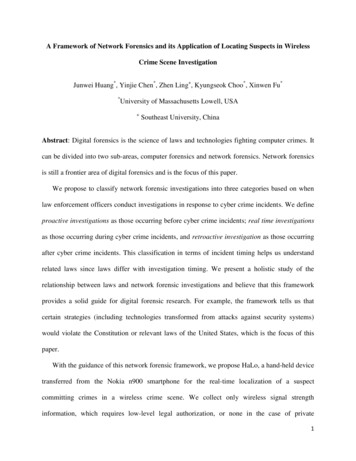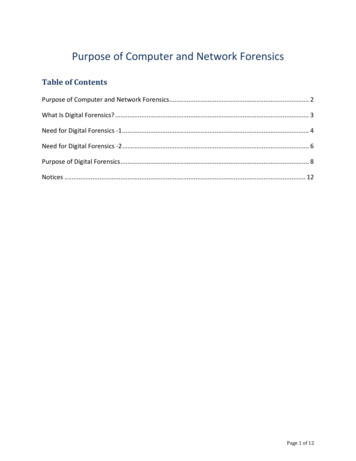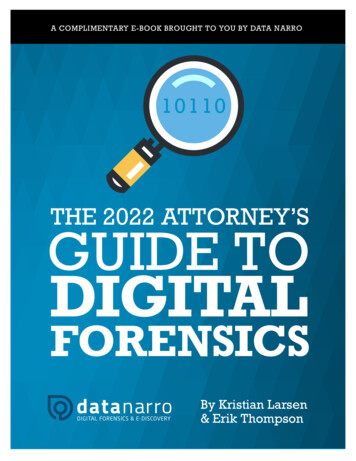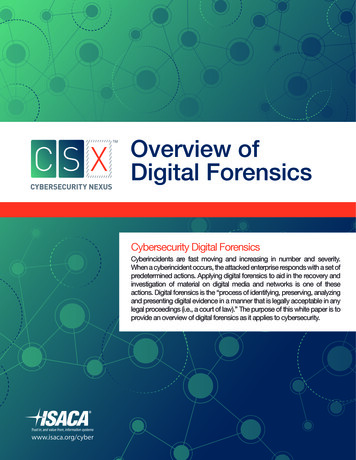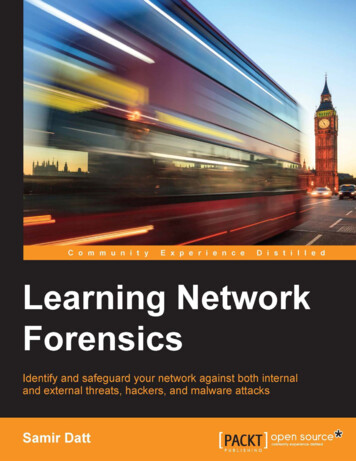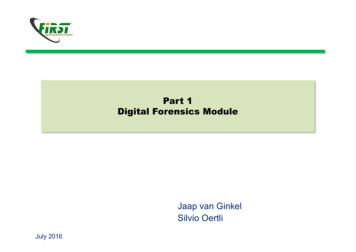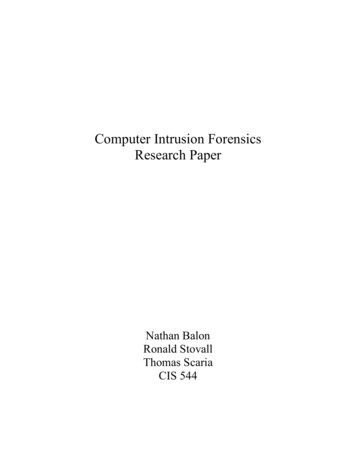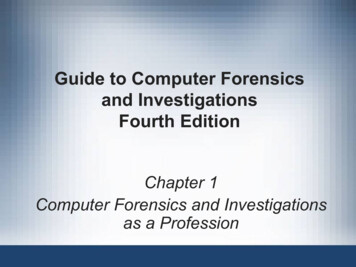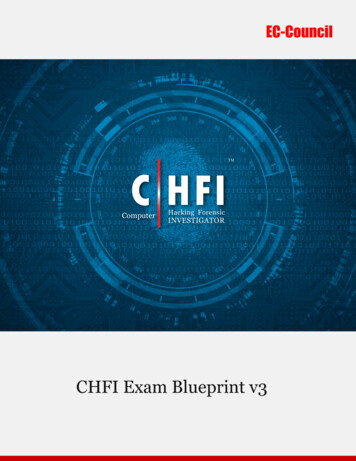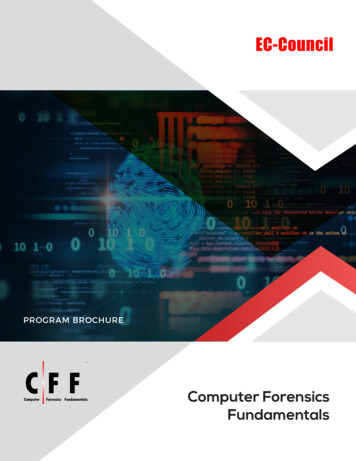
Transcription
Digital Forensics for Network,Internet, and Cloud Computing
Digital Forensics for Network,Internet, and Cloud ComputingA Forensic Evidence Guide for MovingTargets and DataTerrence V. LillardClint P. GarrisonCraig A. SchillerJames SteeleTechnical Editor Jim MurrayAMSTERDAM BOSTON HEIDELBERG LONDONNEW YORK OXFORD PARIS SAN DIEGOSAN FRANCISCO SINGAPORE SYDNEY TOKYOSyngress is an imprint of ElsevierSYNGRESS
Syngress is an imprint of Elsevier.30 Corporate Drive, Suite 400, Burlington, MA 01803, USAThis book is printed on acid-free paper. 2010 Elsevier Inc. All rights reserved.No part of this publication may be reproduced or transmitted in any form or by any means, electronic or mechanical, including photocopying, recording, or any information storage and retrieval system, without permission in writing from the publisher. Details on howto seek permission, further information about the Publisher’s permissions policies and our arrangements with organizations such as theCopyright Clearance Center and the Copyright Licensing Agency, can be found at our Web site: www.elsevier.com/permissions.This book and the individual contributions contained in it are protected under copyright by the Publisher (other than as may be noted herein).NoticesKnowledge and best practice in this field are constantly changing. As new research and experience broaden our understanding, changesin research methods, professional practices, or medical treatment may become necessary.Practitioners and researchers must always rely on their own experience and knowledge in evaluating and using any information,methods, compounds, or experiments described herein. In using such information or methods, they should be mindful of their ownsafety and the safety of others, including parties for whom they have a professional responsibility.To the fullest extent of the law, neither the Publisher nor the authors, contributors, or editors, assume any liability for any injury and/ordamage to persons or property as a matter of products liability, negligence or otherwise, or from any use or operation of any methods,products, instructions, or ideas contained in the material herein.Library of Congress Cataloging-in-Publication DataDigital forensics for network, Internet, and cloud computing: a forensic evidence guide for moving targets and data/TerrenceLillard . [et al.].p. cm.Includes index.ISBN 978-1-59749-537-0 (pbk. : alk. paper) 1. Computer crimes—Investigation. 2. Computer security. 3. Computer networks—Security measures. 4. Cloud computing—Security measures. I. Lillard, Terrence.HV8079.C65D54 2010363.250285’4678—dc222010014493British Library Cataloguing-in-Publication DataA catalogue record for this book is available from the British Library.ISBN: 978-1-59749-537-0Printed in the United States of America10 11 12 135 4 3 2 1Elsevier Inc., the author(s), and any person or firm involved in the writing, editing, or production (collectively “Makers”) of this book(“the Work”) do not guarantee or warrant the results to be obtained from the Work.For information on rights, translations, and bulk sales, contact Matt Pedersen, Commercial Sales Director and Rights;e-mail m.pedersen@elsevier.comFor information on all Syngress publications,visit our Web site at www.syngress.comTypeset by: diacriTech, Chennai, India
ContentsAbout the Authors .xiPART IINTRODUCTIONCHAPTER 1 What Is Network Forensics? . 3Introduction to Cloud Computing .6Introduction to the Incident Response Process .10Investigative and Forensics Methodologies .14Where Network Forensics Fits In .17Summary .19References .20PART IIGATHERING EVIDENCECHAPTER 2 Capturing Network Traffic .23The Importance of DHCP Logs .24Using tcpdump/WinDump .24Limitations of tcpdump.25tcpdump Command Line .25Troubleshooting tcpdump .34Using Wireshark.36Wireshark GUI .37Limitations of Wireshark .42Limitations of Using Libpcap and Derivatives .43Wireshark Utilities .44TShark.44Rawshark .46Dumpcap .46Mergecap .47Editcap .48Text2pcap .48Using SPAN Ports or TAPS .48SPAN Port Issues .49Network Tap .50Using Fiddler.51Firewalls .56Placement of Sensors .57Summary .58v
vi ContentsCHAPTER 3 Other Network Evidence .59Overview of Botnets and Other Network-Aware Malware .62The Botnet Life Cycle .63Temporal, Relational, and Functional Analysesand Victimology .65First Responder Evidence .67Sources of Network-Related Evidence .69Dynamic Evidence Capture .85Malware Analysis: Using Sandbox Technology .90Summary .92PART III ANALYZING EVIDENCE WITH OPEN SOURCE SOFTWARECHAPTER 4 Deciphering a TCP Header .95OSI and TCP Reference Models .96TCP Header .98Source Port Number .100Destination Port Number .101Sequence Number .101Acknowledgment Number .102Data Offset .102Reserved.103TCP Flags .103Windows Size .106TCP Checksum .106Urgent Pointer .106TCP Options .106Padding .107Decipherment of a TCP Segment.107TCP Signature Analysis .108Summary .111CHAPTER 5 Using Snort for Network-Based Forensics .113IDS Overview.114Snort Architecture .116Real-Time Network Traffic Capturing .118Playback Binary Network Traffic (pcap Format) .118Snort Preprocessor Component .118Snort Detection Engine Component .123Network Forensics Evidence Generated with Snort .129Summary .132
Contents viiPART IV COMMERCIAL NETWORK FORENSICS APPLICATIONSCHAPTER 6 Commercial NetFlow Applications . 135What Is NetFlow? . 135How Does NetFlow Work? . 136The Benefit of NetFlow . 137NetFlow Collection . 138NetFlow User Datagram Protocol (UDP) Datagrams. 139NetFlow Header . 139Enabling NetFlow . 140Enabling NetFlow v9 (Ingress and Egress) . 144What Is an FNF? . 146Key Advantages . 146Enabling FNF. 147What Is an sFlow? . 151Enabling sFlow . 152Which Is Better: NetFlow or sFlow?. 153Scrutinizer . 154Scaling . 154Scrutinizer Forensics Using Flow Analytics. 155Using Flow Analytics to Identify Threats within NetFlow . 161Summary . 163CHAPTER 7 NetWitness Investigator . 165Introduction . 165NetWitness Investigator Architecture . 166Import/Live Capture Network Traffic . 167Collections . 168Parsers, Feeds, and Rules . 169Navigation Views . 172Data Analysis . 174Exporting Captured Data . 176Summary . 177CHAPTER 8 SilentRunner by AccessData . 179History of SilentRunner . 179Parts of the SilentRunner System . 181Installing SilentRunner . 184Stand-Alone Installation . 184Distributed Installation . 189
viii ContentsSilentRunner Terminology . 191Graphs.191Spec Files.191Customizing the Analyzer .209Context Management .213Data Investigator Tools .215Some Final Tricks and Tips .216Summary .218References .218PART VMAKING YOUR NETWORK FORENSICS CASECHAPTER 9 Incorporating Network Forensics into Incident Response Plans .221Investigation Method .222Incident Response .224Spearphishing .225DMCA Violations .244Web Site Compromise: Search Engine Spam and Phishing .261Summary .274References .274CHAPTER 10 Legal Implications and Considerations .275Internet Forensics .277Admissibility of Internet Evidence .277Hearsay Exceptions and Internet Evidence .279Cloud Forensics .282Evidence Collection in the Cloud .282Admissibility of Cloud Evidence .284E-Discovery in the Cloud .286International Complexities of Internet and Cloud Forensics .288The Hague Convention on Evidence .292Privacy .293Summary .296References .297Case Law .298Legislation .299CHAPTER 11 Putting It All Together .301Network Forensics Examiner Skills.301Network Forensics Investigation Life Cycle .302Summary .315
Contents ixPART VITHE FUTURE OF NETWORK FORENSICSCHAPTER 12 The Future of Cloud Computing .319History of Cloud Computing .320What Drives the Cloud .321A Break from Dependence on IT to Solve a Business Problem .322The Cloud Is Enabled through Virtualization .322Accelerating Development and Delivery of New Applications .323Private versus Public Cloud Computing .324Which Cloud Vendors Will Rise to the Top?.324Yes, There Are Risks .326The Risks Are Worthwhile .326Will Microsoft and Google Be the 1000-PoundGorillas of the Cloud?.326The Current State of Cloud Computing .328Cloud Usage Patterns.328Who Will Host the Cloud? .328Cloud Computing and Collective Intelligence .329Security and IT from the Cloud .330Other Widely Used Cloud Applications .331Cloud Market Size .332Elements of the Cloud .333The U.S. Federal Government Is Leading the Movementto the Cloud .334Rapid Rate of Change .334Common Security Risks of the Current Cloud .335Next Phases of Cloud Computing .336New Database Models Will Greatly Change Product Creation .336Integrated Applications Will Accelerate Cloud Product Creation.336Microsoft Azure Will Enable a Cloud Cottage Industry .337Other Changes in the New Cloud World .337Security Improvements in the Future Cloud.338Summary .339CHAPTER 13 The Future of Network Forensics .341Today’s Challenges with Existing Devices for Network Forensics .342Network Forensics Quadrants of Focus .342Network Forensics Analysis Tools.345Summary .347INDEX . 349
About the AuthorsLead AuthorTerrence V. Lillard (Linux , CEH, CISSP) is an information technology (IT) security architect and cybercrime and cyberforensics expert. He was a contributing author of the CompTIALinux Certification Study Guide (Exam XK0-003) and the Eleventh Hour Linux (Exam XK0003 Study Guide). He is actively involved in computer, intrusion, network, and steganographycybercrime and cyberforensics cases, including investigations, security audits, and assessments – both nationally and internationally. Terrence has testified in U.S. District Court as acomputer forensics/security expert witness. He has designed and implemented security architectures for various government, military, and multinational corporations. His backgroundincludes positions as principal consultant at Microsoft, the IT Security Operations Managerfor the District of Columbia’s government IT Security Team, and instructor at the DefenseCyber Crime Center’s Computer Investigation Training Academy Program. He has taught ITsecurity and cybercrime/cyberforensics at the undergraduate and graduate level. He holds aBS in electrical engineering and a Master of Business Administration (MBA). In addition, heis currently pursuing a PhD in information security.ContributorsClint P. Garrison (MBS/MS, CISSP, CISM) has over 15 years of experience in informationsecurity, law enforcement, and digital forensics. He currently manages enterprise security andcompliance programs for a Fortune 100 global online retailer and teaches Cyber Crimes andInformation Systems Security for the University of Phoenix’s graduate degree program. He is amember of several regional working groups dedicated to improving cloud computing security,compliance, and forensics initiatives, and he volunteers as a police officer for a small Texascommunity.Clint has a BS in administration of criminal justice from Mountain State University, an MS inIT, and a MBA in information assurance from the University of Dallas. Clint is also a CertifiedInformation System Security Professional (CISSP) and a Certified Information SecurityManager (CISM). He also holds an active Master Peace Officer license and Instructor licensefrom the Texas Commission on Law Enforcement Standards and Education.Craig A. Schiller (CISSP-ISSMP, ISSAP) is the Chief Information Security Officer forPortland State University, an adjunct instructor of security management for Portland StateUniversity, an adjunct instructor of digital forensics for Portland Community College, andPresident of Hawkeye Security Training, LLC. He is the primary author of Botnets – TheKiller Web App (Syngress, ISBN: 9781597491357) and the first Generally accepted SystemSecurity Principles (GSSP). He is a contributing author of several editions of the Handbookof Information Security Management and Data Security Management. Craig was also acontributor to Virtualization for Security (Syngress, ISBN 9781597493055), Infosecurityxi
xii About the Authors2008 Threat Analysis (Syngress, ISBN: 9781597492249), Combating Spyware in theEnterprise (Syngress, ISBN: 1597490644), and Winternals Defragmentation, Recovery, andAdministration Field Guide (Syngress, ISBN: 1597490792).Craig was the senior security engineer and coarchitect of the NASA, Mission Operations AISSecurity Engineering Team. He cofounded two ISSA U.S. regional chapters – the Central PlainsChapter and the Texas Gulf Coast Chapter – and is currently the Director of Education for ISSAPortland. He is a Police Reserve Specialist for the Hillsboro Police Department in Oregon.James “Jim” Steele (CISSP #85790, ACE, DREC, MCSE: Security, Security ) is Manager ofDigital Forensics with a large wireless carrier. His responsibilities include performing workstation, server, PDA, cell phone, and network forensics, as well as acting as a liaison to multiplelaw enforcement agencies, including the United States Secret Service and the FBI. On a dailybasis, he investigates cases of fraud, employee integrity, and compromised systems. Jim has acareer rich with experience in the security, computer forensics, network development, and management fields. For over 18 years, he has played integral roles regarding project management,systems administration, network administration, and enterprise security management in publicsafety and mission-critical systems. As a senior technical consultant with iXP assigned to theNYPD E-911 Center, he designed and managed implementation of multiple systems for enterprise security; he also supported operations on-site during September 11, 2001, and the blackoutof 2003. Jim has also participated in foreign projects such as the development of the LondonMetropolitan Police C3i Project, for which he was a member of the Design and Proposal Team.His career as a technical consultant also includes time with the University of Pennsylvania andthe FDNY. He is a member of HTCC, NYECTF, InfraGard, and the HTCIA. Jim has contributed to several Syngress books, including Cyber Crime Investigations: Bridging the Gaps andCisco Router Forensics.Technical EditorJim Murray is an information security architect for NCCI Holdings, Inc. in Boca Raton, FL.For the past 12 years, he has served in various IT roles at NCCI with a primary focus on network services and information security. Jim currently holds various certifications, includingthe CISSP, CEH, EnCE, and a number of GIAC certifications from the SANS Institute. He hasalso served as a local mentor and community instructor for SANS and coauthored the SANSSecuring Linux Step By Step Guide.
Information System Security Professional (CISSP) and a Certifi ed Information Security Manager (CISM). He also holds an active Master Peace Offi cer license and Instructor license from the Texas Commission on Law Enforcement Standards and Education. Craig A. Schiller (CISSP-ISSMP, ISSAP) is the Chief Information Security Offi cer for
